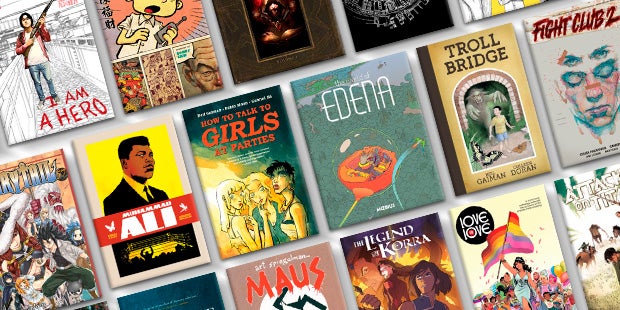A lot has changed in the relationship between graphic novels and librarians or educators over the past decade. The Penguin Random House Library Marketing team is excited to report on the growth of graphic novels in their channel. Read on to learn more about the ways graphic novels for young readers are on the rise.
Ten years ago, marketing graphic novels was a small part of what we did on a daily basis, but each year the demand has grown stronger and stronger, especially for titles appropriate for younger and more diverse audiences.
As a result, we’ve shifted a lot of our marketing focus—especially at major conferences—to graphic-novel authors and panel discussions. Recently, we’ve started doing our own library con at ALA Annual, where we present to an audience of more than three hundred librarians. Graphic novels are always big topics at these meetings. Beyond that, we set up graphic-novel events and book clubs throughout the year, and demand continues to grow.
Here are a few exciting trends and relevant initiatives that we’ve developed in response:
A Growing, Active Readership in Libraries
Graphic novels in libraries have moved from the “reluctant reader” section to the section where the most enthusiastic readers anxiously await an author’s next book in a series or discover a favorite new author. Teachers and librarians are also using nonfiction graphic novels more and more in the last few years as a tool to teach younger students important lessons from history.
As first noted in this 2013 Publishers Weekly article, graphic novels tend to boost library circulation. More recently, in Librarian to Librarian (Brodart), Kat Kan said, “In my own school library, graphic novels account for 25 to 60 percent of circulation per week.”
DC Comics Partnership
This year, DC launched its books for young readers program that publishes original graphic novels specifically designed for middle grade (ages 8-12) and young adult (ages 13+) readers. To tap into this younger audience, DC is partnering with a roster of bestselling young-adult and middle-grade authors to create diverse, relatable stories starring DC’s most iconic characters, such as Batman, Superman, Wonder Woman, and many more.
“Superhero stories have exploded in popularity in recent years,” explains Michele R. Wells, vice president and executive editor for DC Books for Young Readers. “We’ve seen the excitement everywhere, in billboards, on TV, in costumes and toys, in games and at theme parks. This shift, combined with the demand from parents, educators, and librarians for stories that entertain and empower while teaching visual literacy, makes this the perfect time for DC to publish content for middle-grade and YA readers.”
Danielle Paige, author of Mera: Tidebreaker, added: “I think kids see themselves on the page. These stories are focused less on traditional superhero moments and more on what makes an actual hero. Kids can be heroes in big ways and small ones in their own lives.”
(DC is a distribution client of Penguin Random House Publisher Services.)
Big Reception at Events
Graphic novelists are also being given prime speaking slots around the country. A few years ago, Senator John Lewis spoke at ALA Annual about the graphic novel he co-authored, March, which became the first comic ever to win the National Book Award.
Similarly, just this past month at our ALA Annual Conference in Washington, D.C., George Takei was welcomed to the stage with a standing ovation by more than three thousand adoring librarians to discuss his graphic-novel memoir, They Called Us Enemy, the heart-wrenching story of his childhood experience in America’s Japanese internment camps. In a speech all too relevant to today’s headlines, he eloquently described his impressions of being removed from his home at gunpoint and his view looking out from behind the camp’s barbed wire at just five years old.
“Graphic Novel Initiative Group” Becomes an ALA Round Table
Finally, last year the American Library Association (ALA) agreed to formally recognize the Graphic Novel Initiative Group as an official round table. This gives the ALA an opportunity to expand their outreach and better tap into grassroots member support for this category across the country.
In short, the world—especially the world of a young person—is more visual than ever. Graphic novels as a genre are a welcome respite from screen time and tell compelling, diverse, and fresh stories. The library market is embracing them more than ever.
Kelly Coyle-Crivelli is Senior Manager, Library Marketing for Penguin Random House.


